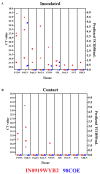Phenotypic Differences Between the Epidemic Strains of Vesicular Stomatitis Virus Serotype Indiana 98COE and IN0919WYB2 Using an In-Vivo Pig (Sus scrofa) Model
- PMID: 39772222
- PMCID: PMC11680245
- DOI: 10.3390/v16121915
Phenotypic Differences Between the Epidemic Strains of Vesicular Stomatitis Virus Serotype Indiana 98COE and IN0919WYB2 Using an In-Vivo Pig (Sus scrofa) Model
Abstract
During the past 25 years, vesicular stomatitis virus (VSV) has produced multiple outbreaks in the US, resulting in the emergence of different viral lineages. Currently, very little is known about the pathogenesis of many of these lineages, thus limiting our understanding of the potential biological factors favoring each lineage in these outbreaks. In this study, we aimed to determine the potential phenotypic differences between two VSV Indiana (VSIV) serotype epidemic strains using a pig model. These strains are representative of the epidemic lineages that affected the US between 1997 and 1998 (IN98COE) and between 2019 and 2020 (IN0919WYB2), the latter responsible for one of the most extensive outbreaks in the US. Our initial genome analysis revealed the existence of 121 distinct mutations between both strains, including the presence of a 14-nucleotide insertion in the intergenic region between the G and L genes observed in IN0919WYB2. The levels of viral RNA in clinical samples between pigs infected with IN98COE or IN0919WYB2 were compared. Overall, higher and prolonged expression of viral RNA in pigs infected with IN98COE was observed. However, clinically, IN0919WYB2 was slightly more virulent than IN98COE, as well as more efficient at producing infection through contact transmission. Additionally, infectious virus was recovered from more samples when the pigs were infected with IN0919WYB2, as revealed by virus isolation in cell culture, indicating the increased ability of this virus to replicate in pigs. Sequence analyses conducted from isolates recovered from both experimental groups showed that IN0919WYB2 produced more variability during the infection, denoting the potential of this strain to evolve rapidly after a single infection-contact transmission event in pigs. Collectively, the results showed that epidemic strains of VSIV may represent disparate phenotypes in terms of virulence/transmissibility for livestock, a situation that may impact the intensity of an epidemic outbreak. This study also highlights the relevance of pathogenesis studies in pigs to characterize phenotypic differences in VSV strains affecting livestock in the field.
Keywords: epidemics; evolution; pathogenesis; transmissibility; vesicular stomatitis virus; virulence.
Conflict of interest statement
The authors declare that the research was conducted without any commercial or financial relationships that could potentially create a conflict of interest.
Figures









Similar articles
-
Surveillance of Feral Swine (Sus scrofa) in the Western USA for Antibodies to Vesicular Stomatitis Virus, 2013-21.J Wildl Dis. 2024 Oct 1;60(4):1011-1015. doi: 10.7589/JWD-D-24-00049. J Wildl Dis. 2024. PMID: 39074817
-
Comparative evaluation of pathogenicity of three isolates of vesicular stomatitis virus (Indiana serotype) in pigs.J Gen Virol. 2019 Nov;100(11):1478-1490. doi: 10.1099/jgv.0.001329. J Gen Virol. 2019. PMID: 31553299
-
Effect of strain and serotype of vesicular stomatitis virus on viral shedding, vesicular lesion development, and contact transmission in pigs.Am J Vet Res. 2004 Sep;65(9):1233-9. doi: 10.2460/ajvr.2004.65.1233. Am J Vet Res. 2004. PMID: 15478770
-
Vesicular Stomatitis Virus.Vet Clin North Am Equine Pract. 2023 Apr;39(1):147-155. doi: 10.1016/j.cveq.2022.11.004. Epub 2023 Feb 1. Vet Clin North Am Equine Pract. 2023. PMID: 36737291 Review.
-
Emergence and re-emergence of vesicular stomatitis in the United States.Virus Res. 2002 May 10;85(2):211-9. doi: 10.1016/s0168-1702(02)00026-6. Virus Res. 2002. PMID: 12034487 Review.
Cited by
-
Near-full-length vesicular stomatitis Indiana virus genome sequences representative of endemic strains circulating in Mexico.Microbiol Resour Announc. 2025 Apr 10;14(4):e0110324. doi: 10.1128/mra.01103-24. Epub 2025 Mar 10. Microbiol Resour Announc. 2025. PMID: 40062770 Free PMC article.
References
-
- Pelzel-McCluskey A., Christensen B., Humphreys J., Bertram M., Keener R., Ewing R., Cohnstaedt L.W., Tell R., Peters D.P.C., Rodriguez L. Review of Vesicular Stomatitis in the United States with Focus on 2019 and 2020 Outbreaks. Pathogens. 2021;10:993. doi: 10.3390/pathogens10080993. - DOI - PMC - PubMed
-
- Velazquez-Salinas L., Pauszek S.J., Zarate S., Basurto-Alcantara F.J., Verdugo-Rodriguez A., Perez A.M., Rodriguez L.L. Phylogeographic characteristics of vesicular stomatitis New Jersey viruses circulating in Mexico from 2005 to 2011 and their relationship to epidemics in the United States. Virology. 2014;449:17–24. doi: 10.1016/j.virol.2013.10.025. - DOI - PubMed
-
- Zarate S., Bertram M., Rodgers C., Reed K., Pelzel-McCluskey A., Gomez-Romero N., Rodriguez L.L., Mayo C., Mire C., Pond S.L.K., et al. Phylogenomic Signatures of a Lineage of Vesicular Stomatitis Indiana Virus Circulating During the 2019–2020 Epidemic in the United States. Viruses. 2024;16:1803. doi: 10.3390/v16111803. - DOI - PMC - PubMed
-
- Dietzgen R.G. Morphology. Genome Organization, Transcription and Replication of Rhabdoviruses. In: Dietzgen R.G., Kuzmin I.V., editors. Rhabdoviruses. Caister Academic Press; Norfolk, UK: 2012. pp. 5–11.
Publication types
MeSH terms
Substances
Grants and funding
LinkOut - more resources
Full Text Sources
Miscellaneous

